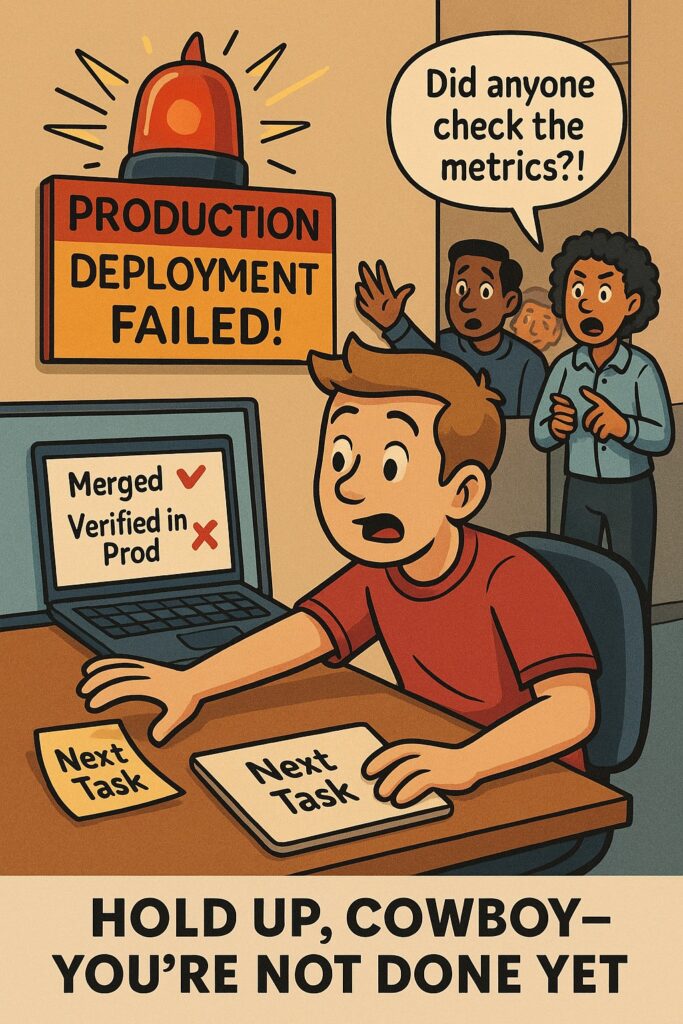How Great Developers Follow Work to the Finish Line

Most engineers stop too early. They finish writing code, get it reviewed and merged, and then immediately grab the next ticket. On paper, that looks productive. But in reality, it’s incomplete. The best developers—the ones who earn trust, get promoted, and receive the biggest bets—treat every task like a full arc, not just a snippet of work.
This post is about that difference. What does true end-to-end ownership look like? And how do you train yourself and your team to stop handing off half-finished work?
Start with the Definition of Done
Before you write a line of code, read all the ticket. What is the actual definition of done? Who needs to verify it? What test data should be available? What documentation or steps need updating?
If you don’t know, ask. Great engineers close the feedback loop before they start building.
Test Like It’s Going to Production—Because It Is
You’re not done when your code runs on your laptop. You’re not done when it compiles. You’re done when a QA engineer or an automated test can validate the exact outcomes that the ticket described.
Even better? If you write the tests yourself—unit tests, integration tests, smoke tests—you’ll catch issues early and sleep easier when it ships.
Follow It Into Production
Don’t vanish after the merge. Great developers follow their code. That means watching it go through staging, keeping an eye on deployment pipelines, and checking on logs and metrics after it hits production.
Whether that’s checking feature flags, watching dashboards, or confirming expected side effects, your work isn’t finished until you’ve seen it succeed in the real world.
Monitor the Right Signals
For app devs: Are you logging the right things? Emitting the right metrics? Setting up alerts that actually help?
For platform and infra folks: Are you measuring latency, error rates, resource usage, and throughput before and after your change? Ownership means knowing how your change affects the system, not just your code file.
Check Again Tomorrow
This is the underused move that separates the good from the great: circle back the next day. Did your change hold up overnight? Did any monitoring fire? Are other teams seeing weird side effects?
By simply reviewing your recent work with fresh eyes (or ears, via feedback), you build a habit of consistent quality—and make fewer mistakes over time.
Make QA’s Job Easy
You know those devs QA groans about? You don’t want to be one of them. Deliver work with everything they need: test credentials, scenarios to try, links to documentation, and a clear summary of what changed and how to verify it.
The smoother you make the hand off, the faster your team ships—and the more your teammates want to work with you.
Build a Reputation That Reduces Friction
When I worked in QA, there were two kinds of developers. When certain names popped up in the commit logs, I braced for bugs. I knew I’d be filing issues, writing rework tickets, and wasting cycles.
But when other names appeared, I knew I had to dig deep to find a single flaw. Their work was just solid. That reputation compounds over time. The trust you build leads to bigger projects, better autonomy, and fewer blockers. You want to be that second type—every time.
Bonus: Empower Others to Finish
If you’re a senior or lead dev, part of following through is helping others do the same. Share your process. Model the behavior. Give feedback on tasks that were technically “done” but not actually complete. You raise the bar, and your whole team benefits.
True Ownership Is Rare—Be the One Who Has It
Anyone can write code. Fewer can ship it. Even fewer still can follow it, test it, support it, and ensure it works in the wild.
The engineers who treat each task like a mission—with a clear outcome and no loose ends—are the ones who get trusted with the hardest, most valuable work. That’s where growth comes from.
So next time you say, “That ticket’s done,” ask yourself:
Is it really?
💡Liked this post?
Get real-world solutions like this in your inbox—join the newsletter.